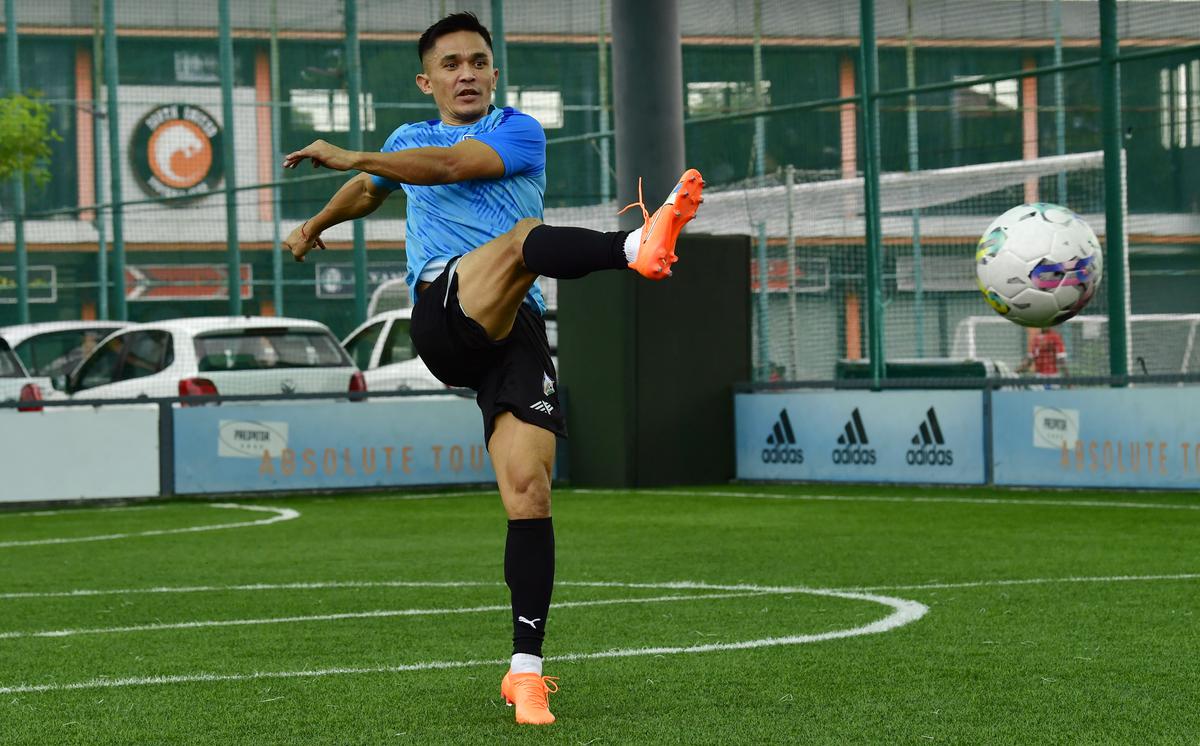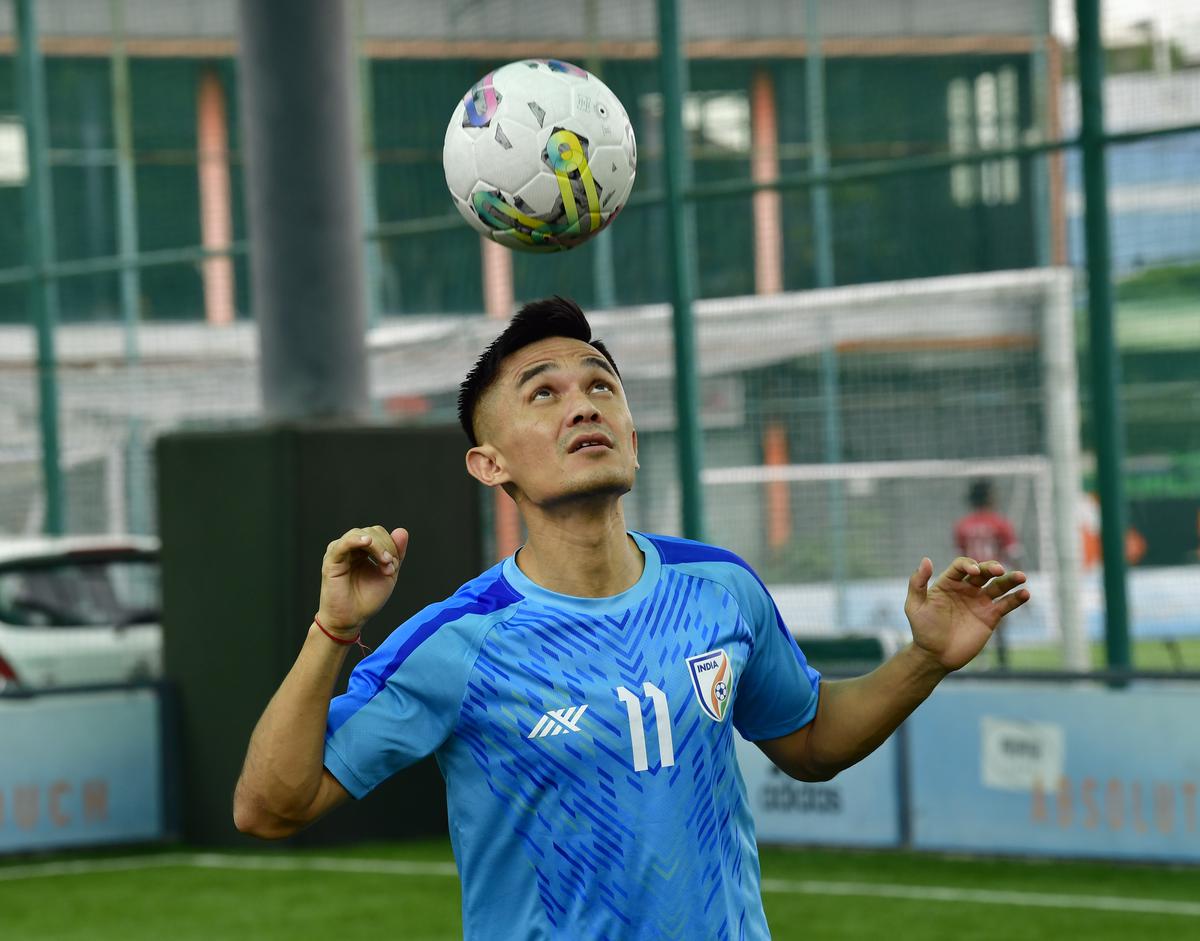Nothing corrodes peak athletic performance quite like time. For ardent fans, it gives that sinking feeling; for the sight of sportspersons trying to reconcile with their ageing bodies even as they attempt to maintain the veneer of immortality that once enveloped their careers is among the most painful things to watch.
A vivid, recent example was that of 43-year-old Venus Williams, a five-time Wimbledon singles champion, braving a fall and battling hard against Elina Svitolina in the first round of The Championships before losing in straight sets.
READ |Interview – Sunil Chhetri
Barely 24 hours later, in faraway India, Sunil Chhetri, soon-to-be 39, was proving to be a huge bulwark against such a march of time. He had just completed his second energy-sapping football game in a four-day window, with both matches stretching beyond 120 minutes. In the process, he had captained India to its ninth SAFF Championship triumph and the silverware was also his nation’s second in under a month.
Chhetri scored five of India’s eight goals during the competition and won the awards for the highest goal-scorer and best player. In the shootout victories over Lebanon and Kuwait in the semifinals and final, he came up with nerveless, tone-setting penalty kicks that set India on course. He then took laps of honour, participated in the Viking thunderclap routines and was repeatedly hoisted high up by his ecstatic teammates. Like Alice did in her Adventures, Chhetri had come to discover an all-new fantastical universe.
Big numbers by Sunil Chhetri
92 international goals — Highest for India, third-highest active goalscorer in the world after Cristiano Ronaldo (123) and Lionel Messi (103)
Only the fourth Indian to score a hat-trick against Pakistan, the other three being Puran Bahadur Thapa, IM Vijayan, and Jeje Lalpekhlua
142 international matches — The most by an Indian
23 goals — The highest goal-scorer in the SAFF Championship, level with Maldivian legend Ali Ashfaq
56 goals — Most goals by an Indian in the ISL
“It’s professionalism [that makes him tick],” says Pradhyum Reddy, who was the assistant coach at Bengaluru FC (BFC) when the club was formed in 2013 and snapped up Chhetri as its marquee signing. “He works harder than anybody else at the club. Every time the club signs a younger player, he uses that as a motivation to get better.
“He has done that in every aspect – the way he looks after himself, his nutrition, his rest, work in the gym and in the off-season. And his mental conditioning is at a different level as compared to most Indian footballers. That helps him compete at this level.”
It is safe to say that Chhetri is both his club and country’s beating heart. In a decade with BFC, he has won the I-League and Federation Cup twice each and the Indian Super League (ISL) and Super Cup once. In the last two seasons, he may have lost his first XI slot, starting only 26 of BFC’s 40 ISL matches, but in clutch moments, he is still the go-to man. En route the final, he accounted for three of BFC’s five goals in the 2022-23 ISL playoffs, all of them scored after coming on as a substitute.
For India, he has 92 goals from 142 games, and is fourth in the all-time list behind Portugal’s Cristiano Ronaldo (123), Iran’s Ali Daei (109) and Argentina’s Lionel Messi (103). He has also been part of four SAFF Championship winning squads and three at the Nehru Cup. One may question the standards of the footballing level that Chhetri has been operating at. But when presented with the opportunity to go overseas — to Kansas City Wizards (USA) and Sporting Lisbon ‘B’ (Portugal) — Chhetri welcomed the challenge without batting an eyelid.
“He is obsessed with football,” says former Australia international Erik Paartalu, who played with Chhetri at BFC from 2017 to 2021. “It’s on the TV when you go over to his house. It’s on his phone [as] he is watching clips. He has also had that exposure of being overseas when young, in America and Portugal. These are grounding experiences. India is a unique ecosystem. Much of [expertise] is in-house. You [can] take things at a higher level of intelligence [abroad] and bring it back to your own country. Doesn’t mean India is lower but it is certainly different.”
As to how much of that knowledge has been imbibed by those individuals around him is tough to gauge. The role-model effect, though real, is difficult to quantify. But their lived experiences, of having Chhetri in the team and by their side, on and off pitch, can be revealing.

As head coach Igor Stimac’s progressive ethos and commitment to full-throttle football grips the Indian national team, it is Chhetri who is leading the charge.
| Photo Credit:
K. MURALI KUMAR
As head coach Igor Stimac’s progressive ethos and commitment to full-throttle football grips the Indian national team, it is Chhetri who is leading the charge.
| Photo Credit:
K. MURALI KUMAR
“I have played with the likes Renedy Singh and Gouramangi Singh, but to play with Sunil was a dream come true,” says Eugeneson Lyngdoh, a former BFC midfielder (2014-17) who won two Federation Cups and one I-League title alongside Chhetri. “The biggest thing for me was how demanding he was of himself.
“You are there [on the pitch] for a reason and there is a huge weight on your shoulders. In such a situation you have to be able to demand from yourself a certain level to get out the best in you. What he asked of himself and how… that spread to the others and lifted the whole team.”
According to Shabbir Ali, former India striker and one of the country’s best players, it is Chhetri’s consistency in his performance graph that is most noteworthy. Sports fans are fickle and they can disown their beloved stars after the slightest of dips in form. India is, after all, a country where even the legendary Sachin Tendulkar was once jeered at.
“Performance matters… take my own case,” recollects Ali, of his playing days in Kolkata for East Bengal in the late 1970s. “If East Bengal or Mohun Bagan lose points before the big [derby] match, fans don’t come to watch football, because the derby match decides the champion. But they came to see my first match and we won 4-0.
“Next match, we lost to Mohun Bagan. The same supporters told me, ‘Shabbir, go back to Bombay’. If you don’t perform, age and everything will come into the picture. Every Tom, Dick and Harry, who doesn’t know anything about football, will start talking.
“So, the way Sunil is playing, you have to give him credit. Most players take it a little light this late in the career. They will just stand in one place and want the ball at their feet always. But Sunil is taking the team forward. Hats off to him.”
Perhaps, the biggest reason Chhetri is able to do what he is doing is his physical conditioning. Today, there is a requirement to be in absolute peak shape almost always, for modern footballers are expected to make far more high-intensity runs than their predecessors, partake in defensive duties by bombing up and down the field and possess the strength to outmuscle opponents in one-on-one combats.
Chhetri, who started his professional journey after the turn of the millennium, has recalibrated his mindset to accomplish all of this and more. When Ashley Westwood, BFC’s first manager, moved him to a more demanding left-sided role from his usual position up top, the talisman made the position his own. Now, as head coach Igor Stimac’s progressive ethos and commitment to full-throttle football grips the Indian national team, it is Chhetri again who is leading the charge.
“He is open with his willingness to look for something new,” says Spencer Mackay, Head of Strength and Conditioning at the Inspire Institute of Sport, where the Indian captain has periodically trained. “Just before Covid, as part of a much broader project, I was gathering some data from the jump routine, which is a test of lower-limb function and explosiveness through the lower body.
“I happened to look at Chhetri’s data and there were some asymmetries; the use of his left hamstring and the right quad and the balance between the two. We spoke about his injury to the left hamstring from four years prior. Probably every year, his hamstring was becoming a bit volatile by the sixth or the eighth week of the ISL.
“So, we tried a program to offset some of the load on the left leg and build it back up. His receptiveness to that was very quick. The moment he saw that there was something that might help him last slightly longer, he was going to take the opportunity.

It is safe to say that Chhetri is both his club and country’s beating heart. In a decade with BFC, he has won the I-League and Federation Cup twice each and the Indian Super League (ISL) and Super Cup once.
| Photo Credit:
K. MURALI KUMAR
It is safe to say that Chhetri is both his club and country’s beating heart. In a decade with BFC, he has won the I-League and Federation Cup twice each and the Indian Super League (ISL) and Super Cup once.
| Photo Credit:
K. MURALI KUMAR
“When you are younger you may have relied a bit more on talent, like he had… like a big fish in a small pond. But [with time], his career has found an increasing level of application. To have something higher than average in every aspect is down to his own desire and work.”
It is however undeniable that Chhetri is in the autumn of his career. BFC may have handed him a contract extension, potentially up to the end of the 2024-25 season, and the man himself may be continuing to drown out retirement talk by letting his feet do the talking.
His eyes are seemingly set on the 2023 AFC Asian Cup in Qatar next January, where India (World No. 100) finds itself in a tough group alongside Australia (No. 27), Uzbekistan (No. 74) and Syria (No. 94). But as the legendary John McEnroe wrote in his memoir, Serious — “It’s never possible to be prepared when the future takes over from the past.”
“There won’t be anyone like him in our lifetime and we should all sit back and enjoy the impact he is having on the pitch,” says Paartalu. “He is a role model, is not a show-off, doesn’t do the wrong things off the field, doesn’t gloat, doesn’t put people down, doesn’t celebrate the small victories.
“He is everything you need in a modern-day footballer. There is too much garbage these days, of posting more stuff online than the minutes spent on the pitch. That’s where the generation is headed. It is no longer the time of being honest and discreet. The thing with Sunil is, he hasn’t had to shout aloud. His successes speak volumes.”



